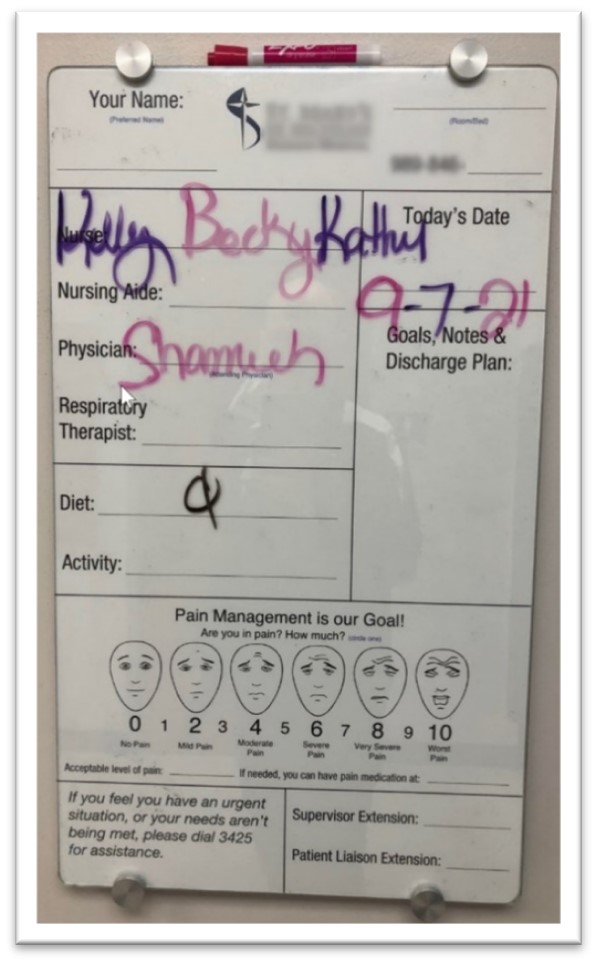After a 45-minute wait in the emergency room waiting area they moved us into an examination room. It was my brothers second trip to ER in the 24 hours since we learned that he had cancer. After completing their assessment they started pumping him with fluids to address his severe dehydration. After this burst of activity the nurses and attendants left the room. I looked around and noticed the large white board on the wall. The board had various categories in black pinstriping and I immediately recognized it as an effort to make information visible. As we sat in the room and the hours passed I started to analyze the unused board (unfortunately I did not think to take a picture!).

A sampling of the board’s categories:
- Patient’s name
- Patient’s pain level and trend
- Attending nurse
- Nurse assistant
- The next step is…
- Tests in process
We ended up being there for over 6 hours. During that time there was a shift change which brought in a new set of nurses, nurse assistants and others. At one point my brother had to use the bathroom but, being connected to various machines, could not just get up and walk out nor did we know where the bathroom was located. I searched around the hallway trying to recognize one of the nurses that had been in the room without success. Finally, I was able to get help. I also was getting constant calls and texts from family members asking what was happening, but I could not tell them since I didn't know myself. As I sat in the room, I reflected on some foundational aspects of making information visible that I coached my teams on in the past. I focused on 4 that could have been applied to improve our experience as ‘customers’ and, it would seem, support the medical staff in providing the best possible care.
- The best visual board / visual management system is one that people actually use. The board in the room was very nice, comprehensive and well laid out but not being used! Was this due to overburdened staff? Lack of training? Lack of leadership? Lack of value? Who knew but I am guessing you have all seen blank or unmaintained boards.
- When you start a visual board make sure you identify the customer. Who was this board intended to help? The staff? The patient? Family members of the patient? Based on the categories listed each of those groups could have benefited. Being clear on who your customer is makes it easier to prioritize what to make visible and who gets the final say on content.
- Make sure you also identify the problem you are trying to solve by visualizing information. The customer will/should have a problem they are trying to solve. You may have primary and secondary customers for the information and it is critical that the creator(s) of the board capture this information and make it the focal point for what is made visible. If you are not solving/improving a problem people have, they will not get value from the board and it is just seen as additional work.
- Visual boards should be dynamic, not static 'wall paper.' The structure of the board is most relevant when it is first created. Then, as the users learn what information is being used, what’s helpful and the environment changes it starts to become less relevant and provides less value leaving less incentive to maintain the board. If you want to increase the use of visual boards avoid fixing the format until your process is mature and conduct short reflection sessions periodically to decide that changes are needed to keep it relevant to the customers.
“If you are not solving/improving a problem people have, they will not get value from the board... ?”
As we sat and waited, I thought about the benefits that would have been created if the visual board was being fully used. First, it would have significantly reduced our stress as 'customers' of the service by knowing who our service providers were and who could answer our questions. Especially “what are we waiting for” and “when my brother might be released.” Second, it would have saved the clearly over-burdened staff time as on more than one occasion I had to search around and ask numerous people questions that would have been available visually in a self-service model. Lastly, it seems like a higher standard of care could have been provided as any new care provider entering the room could have within seconds understood the most important information about the patient and how their role related to his care. This was especially true as we were there over a shift change, when it seemed the staff was asking me questions and flipping through pages of mostly irrelevant information in his chart.

Whether you are visualizing information in manufacturing, product development or a medical service take the time to get the key users and customers involved in addressing the four areas above. This foundational work will greatly increase your chances of long-term sustainment.
What areas do you see as foundational when starting to make information visible? Have you seen unused ‘wallpaper?’ If so, were any of the 4 items outlined above not addressed? Other failure modes?
Postscript: In the six months since the ER visit despite visiting dozens of health care providers I have yet to find evidence of a fully utilized visual board supporting the patient/care-giver interaction. While I believe this is a missed opportunity, my brother has received excellent care during a difficult time for health care workers which has had a significant positive impact on his health and well-being.

Matt Albin
Matt works for Spark Performance Solutions, LLC whose purpose is to help organizations achieve their goals by unleashing the knowledge and creativity of their staff through effective solutions for eLearning and talent development

